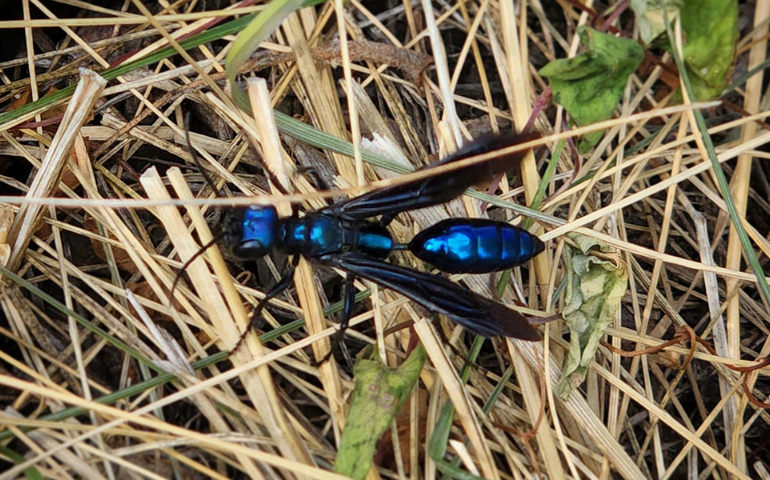Blue and Black Wasps
In the intricate world of wasps, the blue wasp is a standout species due to its unique metallic blue coloring, setting it apart from the more familiar black and yellow wasps. Here at Alta Pest Control, we’ve noted a rising curiosity about these creatures—specifically their characteristics, how they differ from other wasps, how to identify their nests, and their lifecycle and habits.
What Exactly is a Blue Wasp?
Blue wasps, known for their vivid metallic blue hue on their thorax and abdomen, are solitary insects unlike the social black and yellow wasps that form large colonies. This striking coloration not only makes them visually distinctive but also aids in their identification. They are a species of wasps called mud daubers and are often referred to by various other names such as dirt divers, blue mud daubers, mud hornets, blue mud wasp, or mud dobbers, reflecting their nesting habits and physical characteristics. They build unique nests, typically out of mud, which can often be found on sheltered surfaces like eaves or deep in unused machinery. Mud dauber nests are constructed as individual chambers where the wasps lay their eggs and store paralyzed prey to feed their larvae upon hatching.
Life Cycle and Habits of Blue Wasps
The life cycle of blue wasps begins with the female selecting a suitable nest site. Once the mud nest is built, the wasp hunts for black widow spiders and other insects, immobilizing them with her sting to provide fresh food for her larvae. These wasps manage populations of various insects, including harmful spiders. Blue wasps are mostly non-aggressive and will only sting when threatened, making understanding their behavior crucial for peaceful coexistence. However, if blue wasps are bothering you, don’t hesitate to call Alta Pest Control to take care of the issue. Our general pest control service takes care of all species of wasps, ants, spiders and various other bugs.
Why Call Alta Pest Control If You’re Dealing With Black And Blue Wasps
While blue and black wasps can peacefully coexist with humans, their presence can be unsettling and, in some cases, hazardous, especially when they build their nests close to human activity. Here’s why you might consider calling professionals like Alta Pest Control:
- Expertise in Identification: Properly identifying the specific type of wasp is crucial for effective management. Our experts are trained to distinguish between different species and understand their behaviors.
- Safe Removal: Removing wasp nests, especially from difficult or risky locations, requires professional skills and equipment to ensure safety and effectiveness.
- Preventive Solutions: Beyond just removal, we provide strategies and solutions to prevent future infestations, ensuring your space remains wasp-free.
At Alta Pest Control, we’re equipped to handle these intriguing yet potentially troublesome insects with care and precision, ensuring safety for both the wasps and your family. If you notice unusual wasp activity, discover a nest on your property, or encounter any other blue bugs, don’t hesitate to reach out for professional assistance.
FAQs – Black And Blue Wasps
Do black and blue wasps sting?
Yes, black and blue wasps can sting. However, like most wasps, they are generally not aggressive and will only sting when provoked or threatened. It’s important to approach them with caution and avoid disturbing their nests.
What happens when a blue wasp stings you?
A sting from a blue wasp can cause pain, swelling, and redness around the sting area, similar to stings from other wasp species. It’s important to clarify that while the blue wasp uses its sting to paralyze its prey, such as spiders, for feeding its larvae, its sting does not have the same paralyzing effect on humans. However, some individuals may experience more severe allergic reactions, including difficulty breathing, swelling of the face or mouth, and dizziness, which require immediate medical attention. These reactions are not due to paralysis but are typical allergic responses that some people have to wasp stings.
How rare is a blue wasp?
Blue wasps are a relatively uncommon species of mud daubers compared to other species. Their striking metallic blue color makes them more noticeable when they are present. These wasps are more prevalent in certain geographic areas, particularly in regions with warmer climates that support a wide variety of insects, which serve as food sources for their larvae. In the United States, they are most commonly found in the southern and southeastern states where conditions are ideal for their nesting habits and life cycle. However, the rarity of blue wasps can vary based on location, making them a notable sighting in less common areas.
What do blue wasps do?
Blue wasps, like other solitary wasps, play a critical role in controlling pest populations. They primarily hunt and paralyze spiders and other insects, which they then use to feed their larvae. This pest control function helps maintain a balance in local ecosystems.
How are black and blue wasps different from regular wasps?
Blue wasps differ from more common wasp species in several ways. Mud daubers are solitary, meaning they do not live in large colonies and do not have the same social structure as other wasps like yellow jackets or hornets. Additionally, their vibrant metallic blue coloring is distinct from the more typical yellow and black patterns seen in other wasps.
What attracts blue mud dauber wasps?
Blue mud dauber wasps are attracted to areas where their prey is abundant. They are also drawn to environments suitable for nest-building, which include sheltered areas such as under eaves, in sheds, or in unused pipes. Minimizing shelter and food sources can help deter blue wasps from nesting near human habitats.
Share article:

